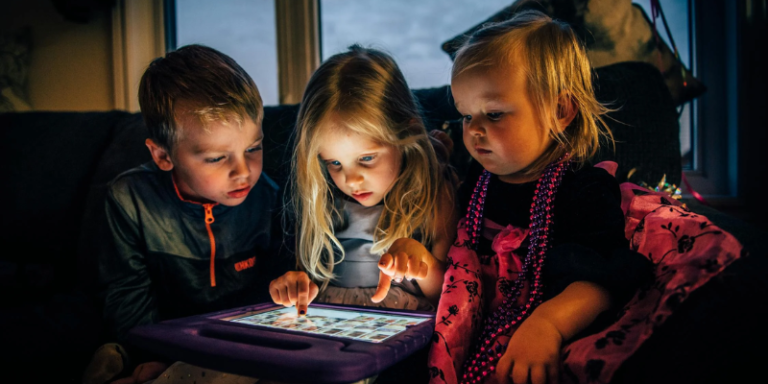With the increasing accessibility of digital devices such as smartphones, tablets, and television, children are engaging with screens more frequently than ever before. While technology offers educational and entertainment benefits, excessive screen addiction can have detrimental effects on a child’s physical health, emotional regulation, cognitive development, and social interactions (American Academy of Paediatrics, 2016; Keikha et al., 2024).
This article provides an evidence-based overview of strategies to reduce screen addiction in children. Drawing on textbook theories, academic research, and guidelines from reputable health organisations, these strategies focus on setting boundaries, promoting alternative activities, and developing healthy digital habits.
1.0 Set Screen Time Limits
Setting appropriate limits on daily screen use is vital to maintaining a healthy balance between screen-based and offline activities. Excessive screen use is linked to issues such as reduced attention, poor sleep quality, and delayed academic skills (Domoff et al., 2019).
According to the Royal College of Paediatrics and Child Health (RCPCH) (2019), consistent rules and open conversations about screen time contribute to better outcomes. Tools such as parental control apps can help enforce boundaries and create accountability.
Tip: Establish a clear daily or weekly screen time budget, and stick to it using visual timers or app-based monitoring tools.
2.0 Create Tech-Free Zones
Designating specific areas of the home—such as bedrooms, dining areas, and study corners—as screen-free zones reduces the temptation to use devices and promotes better sleep and communication (Robinson, 2021). Keeping screens out of sleep environments helps protect circadian rhythms and improve overall wellbeing.
Tip: Encourage the whole family to follow tech-free rules in designated areas, leading by example and creating consistency.
3.0 Encourage Balanced Activities
Children are more likely to reduce screen use when engaging alternatives are readily available. Activities such as reading, drawing, outdoor play, music, and board games can fulfil their need for entertainment and stimulation (Straker et al., 2017).
Keikha et al. (2024) note that increasing access to diverse, stimulating non-digital experiences significantly reduces screen dependency across various age groups.
Tip: Rotate and refresh offline activity options regularly to prevent boredom and foster creativity.
4.0 Be a Role Model
Parental behaviour plays a key role in shaping children’s media habits. Children are more likely to manage their screen use effectively when they observe their caregivers engaging in offline hobbies, meaningful conversations, and screen-free moments (Hiniker et al., 2016).
Tip: Avoid checking devices during meals, conversations, or family time. Demonstrate your own boundaries with screen use.
5.0 Establish Screen-Free Times
Creating device-free routines—such as during meals, before bedtime, or while engaging in shared family activities—promotes meaningful interactions and supports healthy development. Excessive evening screen use has been shown to delay sleep onset and impact melatonin levels (Gentile et al., 2014).
Tip: Implement a “no screens after dinner” policy or create a family media schedule that allows for structured screen breaks.
6.0 Monitor Content Carefully
It is not only the amount of screen time that matters but also the type of content being consumed. Exposure to violent, commercialised, or age-inappropriate material has been linked to behavioural problems, emotional distress, and unhealthy attitudes (Livingstone et al., 2017).
Tip: Choose educational or age-appropriate platforms, use filters, and engage in co-viewing to better understand and discuss what your child is watching or playing.
7.0 Promote Active and Educational Screen Use
Not all screen time is passive. Educational apps and interactive games that involve physical movement, problem-solving, or creative thinking are more beneficial than passive consumption. Active screen use can promote language development, executive function, and fine motor skills (Straker et al., 2017).
Tip: Encourage digital tools that require interaction, and always be present to guide the experience and reinforce learning.
8.0 Reward Positive Behaviour
Positive reinforcement can be a powerful motivator. Children who are praised or rewarded for choosing non-screen activities or following digital limits are more likely to internalise those behaviours (Hollis et al., 2016).
Tip: Use charts, tokens, or verbal praise to recognise screen-free choices and follow through with enjoyable offline rewards such as special outings or family time.
9.0 Maintain Open Communication
Rather than dictating screen rules, involve children in conversations about why balance is important. Explaining the benefits of limiting screen use—such as improved energy, better relationships, and more fun—helps children feel included and respected (Palladino, 2015).
Tip: Ask open-ended questions like “What was your favourite part of today that didn’t involve a screen?” to spark discussion and reflection.
10.0 Seek Professional Guidance When Needed
If screen use is interfering with your child’s behaviour, sleep, or emotional wellbeing, it may be time to consult a professional. The Problematic Media Use Measure (PMUM) developed by Domoff et al. (2019) can help identify signs of screen addiction, including withdrawal, tantrums, and loss of interest in other activities.
Tip: Speak with a paediatrician, school counsellor, or child psychologist if concerns persist despite efforts to manage screen habits.
The Role of Parenting Programmes and Community Support
Evidence-based programmes like Triple P (Positive Parenting Program) and BePresent offer guidance and support for families navigating digital media use. These initiatives have shown positive outcomes in managing screen-related behaviours and enhancing family communication (Baumel et al., 2025).
Community campaigns and screen-free challenges can further reinforce positive behaviour and create supportive peer environments for children and parents alike (Keikha et al., 2024).
Managing screen use in children requires a thoughtful, consistent approach that involves clear limits, engaging alternatives, and strong communication. Rather than eliminating screens altogether, the goal is to cultivate a balanced media diet that supports children’s mental health, relationships, and learning. When used intentionally, technology can become a tool for growth, not a barrier to it. The key lies in setting the right tone at home—where screens are just one part of a rich and varied daily experience.
References
American Academy of Paediatrics (2016). Media and Young Minds. Paediatrics, 138(5), pp. 25–91.
Baumel, A., Mishina, K., Kinnunen, M., & Ristkari, T. (2025). BePresent universal internet-based parenting intervention. Journal of Medical Internet Research, 27(1), e65391. https://www.jmir.org/2025/1/e65391/
Domoff, S.E. et al. (2019). Development and validation of the Problematic Media Use Measure. Psychology of Popular Media Culture, 8(1), pp. 2–11.
Gentile, D.A. et al. (2014). Protective effects of parental monitoring of children’s media use. JAMA Paediatrics, 168(5), pp. 479–484.
Hiniker, A., Schoenebeck, S.Y., & Kientz, J.A. (2016). Not at the dinner table. CSCW Proceedings, pp. 1374–1387.
Hollis, J.L. et al. (2016). Physical activity in secondary school lessons. Int. J. Behav. Nutr. Phys. Act., 13(1), pp. 1–14.
Keikha, M., Ebrahimi, M.H., & Dianati-Nasab, M. (2024). Interventions to prevent unhealthy digital habits. Frontiers in Public Health, 12, Article 1517367. https://www.frontiersin.org/journals/public-health/articles/10.3389/fpubh.2024.1517367/full
Livingstone, S., Davidson, J. & Bryce, J. (2017). Children’s Online Activities and Risks. In: Holloway, D. & Green, L. (Eds.) Digital Childhoods: Technologies and Children’s Lives, pp. 91–108.
Palladino, J. (2015). Parenting in the Age of Digital Technology. Journal of Media Literacy Education, 7(1), pp. 5–25.
RCPCH (2019). Screen Time Guidelines. Royal College of Paediatrics and Child Health. [Online] Available at: https://www.rcpch.ac.uk/news-events/news/new-screen-time-research-published-rcpch-responds
Robinson, T.N. (2021). Reducing children’s television viewing. JAMA, 282(16), pp. 1561–1567.
Straker, L. et al. (2017). Guidelines for electronic game use in children. Ergonomics, 60(1), pp. 152–163.









